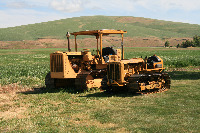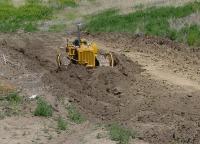- Posts: 134
- Thank you received: 1

ACMOC Membership Benefits
- FREE quarterly magazine filled with content about antique Caterpillar machines
- FREE classified listings
- ACMOC store discounts and specials
- Full Bulletin Board Access
- Marketplace (For Sale/Wanted)
- Technical Library
- Post attachments
$44 /year ELECTRONIC
$60 /year USA
$77 /year International
(pictures) farming with steel tracks
9U(2), 5J, IHC544, Ford860
Please Log in or Create an account to join the conversation.
Tanker, that looks like quite a project. That chain cover looks like a project in itself!!
ACMOC Member 27 years
D47U 1950 #10164
Cat 112 1949 #3U1457
Cat 40 Scraper #1W-5494
Please Log in or Create an account to join the conversation.
- Bleedinred
-

- Offline
- Senior Boarder
- User
- Posts: 56
- Thank you received: 0
Please Log in or Create an account to join the conversation.
ACMOC Member 27 years
D47U 1950 #10164
Cat 112 1949 #3U1457
Cat 40 Scraper #1W-5494
Please Log in or Create an account to join the conversation.
That C65 is one of the first ones ever built and still going strong.
The tracks look like they are reversed on that Cat or are my eyes going batty, Bleedinred.
Please Log in or Create an account to join the conversation.
- North Idaho Farmer
-
 Topic Author
Topic Author
- Offline
- Elite Boarder
- User
- Posts: 224
- Thank you received: 0
If I remember correctly that is a 9500 sidehill? How much more capacity does that have compared to a 6622?
Please Log in or Create an account to join the conversation.
- Bleedinred
-

- Offline
- Senior Boarder
- User
- Posts: 56
- Thank you received: 0
Old Tracks, yep, your eyes are great! When the tracks were replaced some years ago the Cat guy suggested reversing them for better traction when backing up heavy equip. and secondly, supposed to not tear the ground up as much when turning. I'm not sure there's much difference in the latter but that's the way they are. I think it's harder on the bars this way on the hard pull.
Jim, have not seen any Shelbourne headers in these hilly parts. Up until the early 90's JD hillside headers were propriatory to their hillside combines as were IH's before the 1470's came out. That's all I can speak to, and after watching one run I would say it wouldn't work because you can't judge cutter bar height good enough. Our stalk height varies quite a bit due to topography and soil variances, and I don't know of anyone that has ever used auto header controls in this country either.
Please Log in or Create an account to join the conversation.
- the square one is the battery box & other is hyd tank.Tanker, what is that big black box on the back of the Cat?
Please Log in or Create an account to join the conversation.
- North Idaho Farmer
-
 Topic Author
Topic Author
- Offline
- Elite Boarder
- User
- Posts: 224
- Thank you received: 0
After harvest is over we decide what type of tillage will need to be done to the wheat stubble, if the crop is light without much residue we just chisel without doing anything to the stubble. If it is heavy and we still want to chisel then we try to roll it once or twice on a dry afternoon. A few neighbors will heavy harrow the stubble instead of roll and in areas without as many rocks such as the palouse and further down the ridge from here they will often use a flail or mower on the heavy straw. All of these operations are best done when it is dry soon after harvest.
We generally roll wheat stubble with the 1155 because of its faster speed.
If we decide we want to moldboard plow the stubble instead of chisel and do it dry to kill perennial weeds then we also do that soon after harvest. Only a couple guys around here do the plowing early.
Once that is done we focus on getting ready to seed, that often means just disking the weed patches and smoothing them out and spreading residue. On canola stubble and some other neighbors plant winter wheat on spring cereals that ground gets tillage of some sort usually though a few do no-till. Many other guys near here work all the legume stubble with a cultivator once or twice and getting into the deeper soil areas toward the palouse they often put fertilizer on before seeding.
By late Sept and early Oct. the winter wheat seeding is going strong, we put on phosphate fertilizer with the seed. We always pull the drills in the fall with the D4D.
After fall seeding, tillage is done on the rest of the ground going into spring crop. D6C does most of the heavy work in the fall.
On the ground that was rolled we end up having to go around and round the field the same way as the roller for it to work right and then work the corners out, goal is to get the residue flat and mixed in with the soil rather than all still standing.
On spring wheat stubble and the other that is not rolled we prefer to chisel back and forth crossways and on the contour when possible.
If the residue it heavy we usually try to harrow the chiseled ground in the fall to help try to grind the straw up a bit and smooth the ground out. Some guys have harrows on the back of their chisels but we havent gotten that to work well.
We also do some spraying in the fall on winter crops if there are weeds present to prevent disease over the long winter under the snow or in the wet.
Please Log in or Create an account to join the conversation.
ACMOC
Antique Caterpillar Machinery Owners Club
1115 Madison St NE # 1117
Salem, OR 97301
support@acmoc.org
"I became a member recently because the wealth of knowledge here is priceless."
- Chris R
"I also joined a year ago. had been on here a couple of times as a non-member and found the info very helpful so I got a one year subscription (not very expensive at all) to try it out. I really like all the resources on here so I just got a three year. I think its a very small price for what you can get out of this site."
- Jason N













